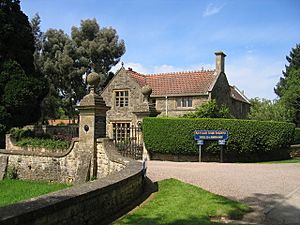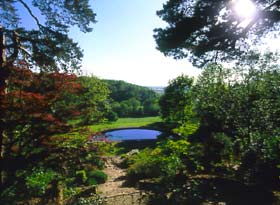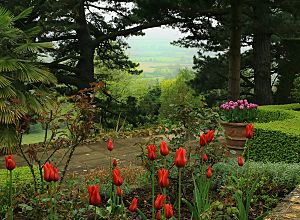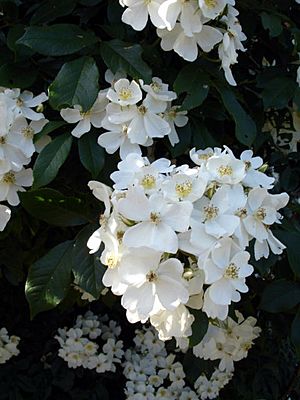Kiftsgate Court Gardens facts for kids
Kiftsgate Court Gardens is a beautiful garden located in Gloucestershire, England. It's famous for its amazing plants, especially its roses! What makes it extra special is that three generations of women in the same family have created and cared for these gardens. It all started with Heather Muir in the 1920s, then her daughter Diany Binny took over in the 1950s, and now her granddaughter Anne Chambers and her husband look after it. Kiftsgate Court is still a family home today.
The gardens are found above the village of Mickleton. This area was once part of an old division called the Kiftsgate Hundred. This was a historical area where local leaders met to make decisions. Today, a special stone marks where the 'Kiftsgate Hundred' meetings used to happen. Kiftsgate is also very close to another famous garden, Hidcote Manor Garden, which is looked after by the National Trust.
Contents
A Look Back: The History of Kiftsgate
Early Ideas and Building the House
Around 1750, a poet and garden designer named William Shenstone visited Mickleton Manor. He had a big idea to plant many trees in the area. He inspired the planting of an elm avenue that once connected Kiftsgate Court and Mickleton Manor. Sadly, these elm trees were lost to a disease in the 1970s. Other trees, like Scotch firs and lime trees, were also planted thanks to Shenstone's vision.
Kiftsgate Court itself was built much later, between 1887 and 1891. The owner, Sydney Graves Hamilton, moved the front part of Mickleton Manor, which had a grand Georgian style, to the new site. Imagine moving a whole house front! They even built a special light railway to do it. The records say they used "only the very best material." However, a large Victorian back was added behind the Georgian front.
Family Changes and Garden Growth
In 1918, Mr. and Mrs. J. B. Muir bought Kiftsgate. They made many changes inside the house. For example, a big ballroom was turned into bedrooms. In 1954, their daughter Diany Binny and her husband Tony Binny moved into Kiftsgate. They made even more changes, pulling down parts of the house to create the large gravel area you see today for parking.
Later, in 1974, Diany Binny moved out, and Kiftsgate was empty for a while. But in 1981, Diany's eldest daughter, Anne, and her husband Jonathan moved in. They updated the house, making it their family home. Kiftsgate Court has remained a family home, just as the original owners intended.
Exploring the Gardens
How the Garden Grew Over Time
Before 1920, the garden at Kiftsgate was quite simple. It had a paved area in front of the house and then just a grassy field with some trees. Mrs. J.B. Muir, who started the garden, began by creating a beautiful lawn with steps leading down to it. Soon after, she added what are now called the Yellow Border and the Rose Border. She also had a connecting bridge built and planted yew and copper beech hedges.
Even after all this work, the family kept going! In 1930, they tackled the steep bank, adding a summer house and steps leading down to a lower part of the garden.
A hard tennis court was built in the 1930s, surrounded by a yew hedge. During World War II, the tennis court was not kept up and became overgrown. Later, in 1955, it was resurfaced and became the modern water garden you can see today.
Inspiration and Recognition
Heather Muir, who started the Kiftsgate garden, was greatly helped and inspired by her friend Major Lawrence Johnston. He created the famous garden right next door at Hidcote Manor. While Kiftsgate was influenced by Hidcote, it was never formally planned. Some people think Kiftsgate is "a prettier, less organised place."
Kiftsgate became well-known to garden lovers after an article was published in 1951. A famous plant expert, Graham Stuart Thomas, wrote that he thought Kiftsgate had "the finest piece of skilled colour work" he had ever seen. In 1954, a magazine called Gardening featured Kiftsgate on its cover, praising how the plants grew to their full size while still being carefully managed to create beautiful "pictures in colour."
The Famous Kiftsgate Rose
The gardens are especially famous for the Kiftsgate rose. This is a very special climbing rose that smells wonderful and grows very strongly, even in the shade. It's claimed that the Rosa filipes 'Kiftsgate' is the largest rose in Britain! It was planted in 1938 and named by Graham Stuart Thomas in 1951. The owners say it would be even bigger if they didn't trim it back. They even worry about the weight of its leaves on the beech tree it has grown onto!
Awards and Special Mentions
- Kiftsgate Court Gardens was named the Historic Houses Association - Christie's Garden of the Year in 2003.
- The house is featured in a book called England's Thousand Best Houses by Sir Simon Jenkins.
- The famous writer Germaine Greer has said that Kiftsgate is her favorite garden.





